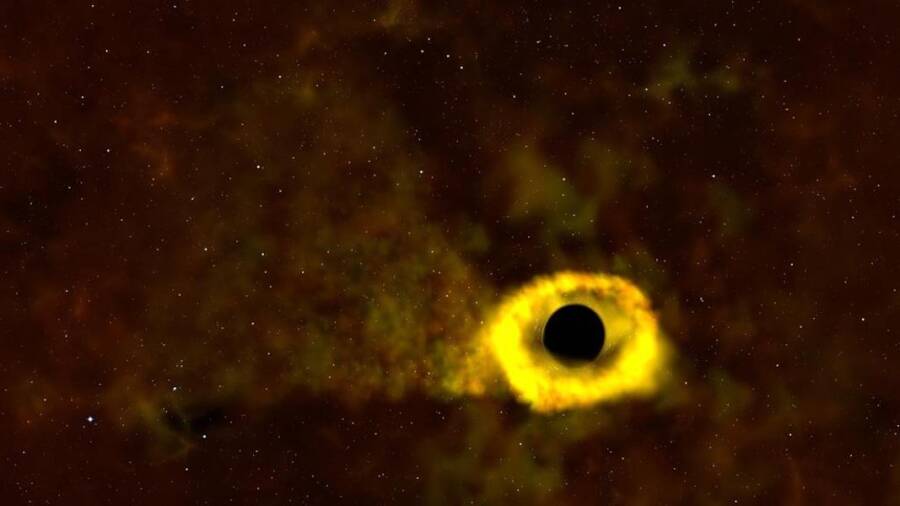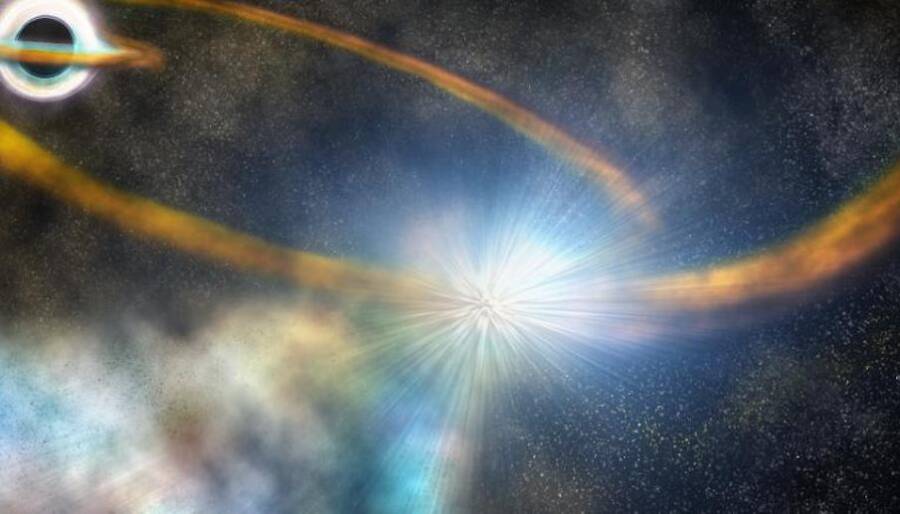Events like this are not only incredibly rare but difficult to capture. NASA managed it with a state-of-the-art satellite and a network of robotic telescopes.

NASA’s Goddard Space Flight Center A computer-generated image of a black hole shredding a star.
Have you ever wondered what a star looks like as it’s ripped apart by a black hole? Probably not. But thanks to NASA and Ohio State University, you don’t have to wonder at all.
According to Ohio radio station WOSU, a NASA satellite and a network of robotic telescopes known as the All-Sky Automated Survey for Supernovae — or ASAS-SN for short — located at the university gave astronomers an unexpected glimpse of the epic cosmic battle back in January of this year.
Courtesy of NASA, we can now watch a computer-generated video of the incredible — and terrifying — event as it unfolded.
The supermassive black hole in question is estimated to weigh approximately 6 million times the mass of our sun and is located in the Volans constellation, some 375 million light-years away from Earth.
So, according to Science Alert, what we’re seeing actually happened 375 million years ago, but the light is only reaching us now.
The ill-fated star was roughly the same size as our sun.
The event, known as a tidal disruption event (TDE), is not only rare — occurring once every 10,000 to 100,000 years in a galaxy the size of the Milky Way — but it also requires very specific conditions to occur.
If a star wanders too close to a black hole, it will be sucked in without a trace. If the star is too far, it’ll simply ricochet off the black hole and be bounced off into space.
If it’s at the perfect distance, the star can be seen in part sucked in by the black hole’s dominating gravity and ultimately ripped apart. Some of that starry material is then shot back out into space as the rest remains trapped in the black hole.
Due to their rarity, these events are very difficult to capture.
“Imagine that you are standing on top of a skyscraper downtown, and you drop a marble off the top, and you are trying to get it to go down a hole in a manhole cover,” Chris Kochanek, professor of astronomy at Ohio State, said in a press release. “It’s harder than that.”
NASA’s Goddard Space Flight Center An artist’s rendering of a star caught in the gravity of a supermassive black hole and ripped to bits.
However, the latest advancements in NASA technology allowed scientists to achieve just that. Apparently, NASA’s TESS satellite, which launched in July 2018, had detected the early signs of a possible TDE.
The satellite’s massive surveying area covers an area of space 400 times larger than that observed by the famed Kepler telescope. Its four wide-field cameras on board are able to scan different sectors of the sky for days at a time.
This particular tidal disruption event has been dubbed ASASSN-19bt. The research team watched it unfold for 42 days before it peaked in brightness 37 days later.
“Only a handful of TDEs have been discovered before they reached peak brightness and this one was found just a few days after it started to brighten,” said Thomas Holoien, an astronomer at the Carnegie Institute for Science.

Robin Dienel/Carnegie Institution for ScienceAn artist’s illustration of the battle between the star and the black hole.
“Plus, thanks to it being in what’s called TESS’ ‘continuous viewing zone,’ we have observations of it every 30 minutes going back months — more than ever before possible for one of these events.”
That data collected from this latest TDE is incredibly valuable as it has never been recorded in such great detail before. The team hopes that the data will allow them to possibly pick up another TDE event in the future.
For instance, they recorded a brief moment of cooling in temperature and fading in the galaxy’s vicinity before its temperature leveled off and its luminosity continued to build toward its peak. This blip is considered “unusual” when compared to other TDE events.
“It was once thought that all TDEs would look the same. But it turns out that astronomers just needed the ability to make more detailed observations of them,” the study’s co-author, Patrick Vallely, said.
The groundbreaking discovery was published in The Astrophysical Journal.
“We have so much more to learn about how they work, which is why capturing one at such an early time and having the exquisite TESS observations was crucial.”
Next up, discover the surreal things that might happen in a black hole. Then read about the seven earth-like planets discovered by NASA in a nearby star’s habitable zone.





